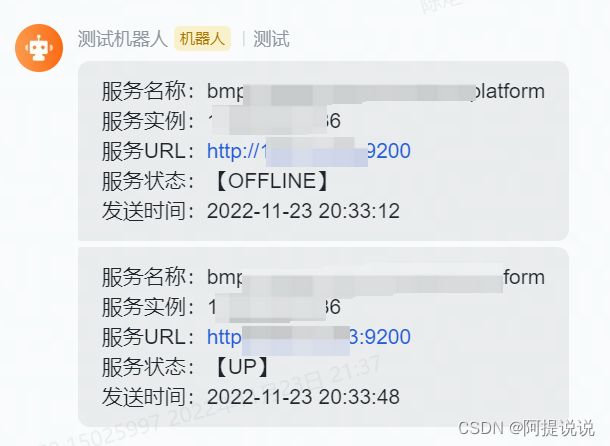Spring Boot Admin2 实例状态监控详解
其他相关文章:
- Spring Boot Admin 参考指南
- SpringBoot Admin服务离线、不显示健康信息的问题
- Spring Boot Admin2 @EnableAdminServer的加载
- Spring Boot Admin2 AdminServerAutoConfiguration详解
在微服务中集成Spring Boot Admin 的主要作用之一就是用来监控服务的实例状态,并且最好是当服务DOWN或者OFFLINE的时候发消息提醒,SBA2 提供了很多提醒方式,并且SBA2 已经集成了钉钉,只要进行少量配置即可将状态变更发送到钉钉,详见我的另外一篇文章《Spring Boot Admin 参考指南》。
SBA2 接入飞书
这里我要说明如何进行自定义提醒,将飞书提醒集成到SBA2中,顺便看看SBA2的状态监控具体是如何实现的。
- 定义配置类
FeiShuNotifierConfiguration
@Configuration(proxyBeanMethods = false)
@ConditionalOnProperty(prefix = "spring.boot.admin.notify.feishu", name = "enabled", havingValue = "true")
@AutoConfigureBefore({ AdminServerNotifierAutoConfiguration.NotifierTriggerConfiguration.class, AdminServerNotifierAutoConfiguration.CompositeNotifierConfiguration.class })
@Lazy(false)
public static class FeiShuNotifierConfiguration {
@Bean
@ConditionalOnMissingBean
@ConfigurationProperties("spring.boot.admin.notify.feishu")
public FeiShuNotifier feiShuNotifier(InstanceRepository repository,
NotifierProxyProperties proxyProperties) {
return new FeiShuNotifier(repository, createNotifierRestTemplate(proxyProperties));
}
}
这里是模仿SBA2 定义其他通知的方式,InstanceRepository 用于实例持久化操作,NotifierProxyProperties 是通知的HTTP代理配置
- 定义消息提醒实现
public class FeiShuNotifier extends AbstractStatusChangeNotifier implements AlarmMessage {
private static final String DEFAULT_MESSAGE = " 服务名称:#{instance.registration.name} \n 服务实例:#{instance.id} \n 服务URL:#{instance.registration.serviceUrl} \n 服务状态:【#{event.statusInfo.status}】 \n 发送时间:#{time}";
private final SpelExpressionParser parser = new SpelExpressionParser();
private RestTemplate restTemplate;
private String webhookUrl;
private String secret;
private Expression message;
public FeiShuNotifier(InstanceRepository repository, RestTemplate restTemplate) {
super(repository);
this.restTemplate = restTemplate;
this.message = parser.parseExpression(DEFAULT_MESSAGE, ParserContext.TEMPLATE_EXPRESSION);
}
@Override
protected Mono<Void> doNotify(InstanceEvent event, Instance instance) {
return Mono.fromRunnable(() -> sendNotify(event, instance));
}
@Override
protected void updateLastStatus(InstanceEvent event) {
//原有的更新最后实例状态,在重启后会删除最后状态,导致实例重启后会过滤掉UNKNOWN:UP通知,这里在重启注册后,将最后的状态重新更新会实例中
//如此实例的变化状态为OFFLINE:UP
//还有一种办法是:重写shouldNotify(),去掉UNKNOWN:UP,不过滤该通知,也能够收到UP通知,但如此会在Admin重启的时候,所有服务的通知都会发一遍
if (event instanceof InstanceDeregisteredEvent) {
String lastStatus = getLastStatus(event.getInstance());
StatusInfo statusInfo = StatusInfo.valueOf(lastStatus);
InstanceStatusChangedEvent instanceStatusChangedEvent = new InstanceStatusChangedEvent(event.getInstance(), event.getVersion(), statusInfo);
super.updateLastStatus(instanceStatusChangedEvent);
}
if (event instanceof InstanceStatusChangedEvent) {
super.updateLastStatus(event);
}
}
private void sendNotify(InstanceEvent event, Instance instance) {
sendData(getText(event, instance));
}
@Override
public void sendData(String content) {
if (!isEnabled()) {
return;
}
Map<String, Object> message = createMessage(content);
doSendData(JSONObject.toJSONString(message));
}
private void doSendData(String message) {
sendWebData(message);
}
private void sendWebData(String message) {
HttpHeaders headers = new HttpHeaders();
headers.setContentType(MediaType.APPLICATION_JSON);
restTemplate.postForEntity(webhookUrl, new HttpEntity<>(message, headers), Void.class);
}
protected Map<String, Object> createMessage(String content) {
Map<String, Object> messageJson = new HashMap<>();
messageJson.put("msg_type", "text");
Map<String, Object> text = new HashMap<>();
text.put("text", content);
messageJson.put("content", text);
Long timestamp = System.currentTimeMillis() / 1000;
messageJson.put("timestamp", timestamp);
messageJson.put("sign", getSign(timestamp));
return messageJson;
}
private String getText(InstanceEvent event, Instance instance) {
Map<String, Object> root = new HashMap<>();
root.put("event", event);
root.put("instance", instance);
root.put("lastStatus", getLastStatus(event.getInstance()));
root.put("time", DateUtil.now());
StandardEvaluationContext context = new StandardEvaluationContext(root);
context.addPropertyAccessor(new MapAccessor());
return message.getValue(context, String.class);
}
private String getSign(Long timestamp) {
try {
String stringToSign = timestamp + "\n" + secret;
Mac mac = Mac.getInstance("HmacSHA256");
mac.init(new SecretKeySpec(stringToSign.getBytes(StandardCharsets.UTF_8), "HmacSHA256"));
byte[] signData = mac.doFinal(new byte[]{});
return new String(Base64.encodeBase64(signData));
}
catch (Exception ex) {
ex.printStackTrace();
}
return "";
}
public void setRestTemplate(RestTemplate restTemplate) {
this.restTemplate = restTemplate;
}
public String getWebhookUrl() {
return webhookUrl;
}
public void setWebhookUrl(String webhookUrl) {
this.webhookUrl = webhookUrl;
}
public String getSecret() {
return secret;
}
public void setSecret(String secret) {
this.secret = secret;
}
public String getMessage() {
return message.getExpressionString();
}
public void setMessage(String message) {
this.message = parser.parseExpression(message, ParserContext.TEMPLATE_EXPRESSION);
}
}
这里继承了AbstractStatusChangeNotifier 用来处理实例状态变更通知,AlarmMessage 是我自己将消息发送给抽象了出来,以便其他告警也能调用。其他都比较简单,飞书的群提醒请参考飞书文档
另外,这里重写了updateLastStatus方法,在取消注册的时候将实例的最后一次状态重新更新到实例中,因为在测试中,实例如果重启,
实例状态变为OFFLINE,但重启完成后,却没有收到UP的消息,查看源码后,SBA2在实例取消注册的时候,删除实例的最后一次状态,导致实例的状态变成UNKNOWN,而SBA2里面shouldNotify方法又会过滤UNKNOWN:UP的状态变更。后面会详细看下这部分的源码。
状态监控源码分析
从《Spring Boot Admin2 AdminServerAutoConfiguration详解》这篇文章我们可以知道,在SBA2启动的时候,会加载StatusUpdater和StatusUpdateTrigger,前者用于更新实例状态,后者用来触发状态更新,这两个类我将从头至下分部说明。
StatusUpdateTrigger
private static final Logger log = LoggerFactory.getLogger(StatusUpdateTrigger.class);
private final StatusUpdater statusUpdater;
private final IntervalCheck intervalCheck;
public StatusUpdateTrigger(StatusUpdater statusUpdater, Publisher<InstanceEvent> publisher) {
super(publisher, InstanceEvent.class);
this.statusUpdater = statusUpdater;
this.intervalCheck = new IntervalCheck("status", this::updateStatus);
}
StatusUpdateTrigger 继承自AbstractEventHandler类,通过构造函数,传入StatusUpdater 更新状态实例,Publisher 接收一个InstanceEvent事件。
super(publisher, InstanceEvent.class) 调用父类构造方法,将Publisher和要关注的事件InstanceEvent传入。
this.intervalCheck = new IntervalCheck(“status”, this::updateStatus) 创建了一个定时任务用来检查实例状态
接下来看下StatusUpdateTrigger 的父类AbstractEventHandler
AbstractEventHandler.start
public void start() {
this.scheduler = this.createScheduler();
this.subscription = Flux.from(this.publisher).subscribeOn(this.scheduler).log(this.log.getName(), Level.FINEST)
.doOnSubscribe((s) -> this.log.debug("Subscribed to {} events", this.eventType)).ofType(this.eventType)
.cast(this.eventType).transform(this::handle)
.retryWhen(Retry.indefinitely().doBeforeRetry((s) -> this.log.warn("Unexpected error", s.failure())))
.subscribe();
}
AbstractEventHandler 的start 方法会在StatusUpdateTrigger 初始化@Bean(initMethod = "start", destroyMethod = "stop") 中被调用,这里其创建了一个定时任务,并订阅了指定的事件类型eventType,如果监听到了感兴趣的事件,会调用handle方法,该方法由子类实现
StatusUpdateTrigger.handle
@Override
protected Publisher<Void> handle(Flux<InstanceEvent> publisher) {
return publisher
.filter((event) -> event instanceof InstanceRegisteredEvent
|| event instanceof InstanceRegistrationUpdatedEvent)
.flatMap((event) -> updateStatus(event.getInstance()));
}
在StatusUpdateTrigger 中 如果事件类型是InstanceRegisteredEvent(实例注册事件)或者InstanceRegistrationUpdatedEvent(实例更新事件),会调用更新实例状态方法
updateStatus
StatusUpdateTrigger.updateStatus
protected Mono<Void> updateStatus(InstanceId instanceId) {
return this.statusUpdater.updateStatus(instanceId).onErrorResume((e) -> {
log.warn("Unexpected error while updating status for {}", instanceId, e);
return Mono.empty();
}).doFinally((s) -> this.intervalCheck.markAsChecked(instanceId));
}
StatusUpdateTrigger.updateStatus 调用了构造函数传入的StatusUpdater Bean 的updateStatus,执行具体的查询实例状态、更新实例状态操作,最后更新该实例的最后检查时间。
StatusUpdateTrigger.start/stop
@Override
public void start() {
super.start();
this.intervalCheck.start();
}
@Override
public void stop() {
super.stop();
this.intervalCheck.stop();
}
StatusUpdateTrigger 最后是Bean初始化调用方法start和销毁时调用的stop方法,分别用于启动其父类AbstractEventHandler的事件监听,和 IntervalCheck 的定时状态检查任务
StatusUpdater
StatusUpdater 是真正去查询实例状态,并更新实例的类,我们在StatusUpdateTrigger.updateStatus中已经看到其会请求StatusUpdater.updateStatus
public Mono<Void> updateStatus(InstanceId id) {
return this.repository.computeIfPresent(id, (key, instance) -> this.doUpdateStatus(instance)).then();
}
repository.computeIfPresent 会调用EventsourcingInstanceRepository.computeIfPresent,表示实例id存在的话,执行doUpdateStatus并更新状态,doUpdateStatus 会查询实例最新状态,并通过Instance.withStatusInfo包装成一个新的Instance 对象。
EventsourcingInstanceRepository.computeIfPresent
@Override
public Mono<Instance> computeIfPresent(InstanceId id,
BiFunction<InstanceId, Instance, Mono<Instance>> remappingFunction) {
return this.find(id).flatMap((application) -> remappingFunction.apply(id, application)).flatMap(this::save)
.retryWhen(this.retryOptimisticLockException);
}
其中this::save 用来保存实例事件,此处为状态变更事件
EventsourcingInstanceRepository.save
public Mono<Instance> save(Instance instance) {
return this.eventStore.append(instance.getUnsavedEvents()).then(Mono.just(instance.clearUnsavedEvents()));
}
eventStore 实际调用的是在AdminServerAutoConfiguration中加载的InMemoryEventStore。
InMemoryEventStore.append
public Mono<Void> append(List<InstanceEvent> events) {
return super.append(events).then(Mono.fromRunnable(() -> this.publish(events)));
}
该方法将在事件保存后,发送一个Publish,这样实现了AbstractEventHandler的类就能监听到该变更事件。
AdminServerNotifierAutoConfiguration
当SBA2中存在通知相关的Notifier Bean时,会开启NotificationTrigger,用来发送变更事件通知
@Configuration(proxyBeanMethods = false)
@ConditionalOnBean(Notifier.class)
@Lazy(false)
public static class NotifierTriggerConfiguration {
@Bean(initMethod = "start", destroyMethod = "stop")
@ConditionalOnMissingBean(NotificationTrigger.class)
public NotificationTrigger notificationTrigger(Notifier notifier, Publisher<InstanceEvent> events) {
return new NotificationTrigger(notifier, events);
}
}
NotificationTrigger 道理同 StatusUpdateTrigger 。
NotificationTrigger.sendNotifications
protected Mono<Void> sendNotifications(InstanceEvent event) {
return this.notifier.notify(event).doOnError((e) -> log.warn("Couldn't notify for event {} ", event, e))
.onErrorResume((e) -> Mono.empty());
}
this.notifier.notify(event) 表示会调用对应通知类的notify方法,这里已飞书为例,由于飞书继承了AbstractStatusChangeNotifier类,该处会调用AbstractStatusChangeNotifier.notify,AbstractStatusChangeNotifier.notify又会调用其父类AbstractEventNotifier的notify方法。
AbstractStatusChangeNotifier.notify
public Mono<Void> notify(InstanceEvent event) {
return super.notify(event).then(Mono.fromRunnable(() -> updateLastStatus(event)));
}
AbstractEventNotifier.notify
public Mono<Void> notify(InstanceEvent event) {
if (!enabled) {
return Mono.empty();
}
return repository.find(event.getInstance()).filter((instance) -> shouldNotify(event, instance))
.flatMap((instance) -> doNotify(event, instance))
.doOnError((ex) -> getLogger().error("Couldn't notify for event {} ", event, ex)).then();
}
在AbstractEventNotifier.notify中会通过shouldNotify判断该事件是否应该通知,该方法由子类实现,因此这里父类又调用了子类AbstractStatusChangeNotifier的实现,如果需要通知,则执行具体的doNotify方法。
AbstractStatusChangeNotifier.shouldNotify
protected boolean shouldNotify(InstanceEvent event, Instance instance) {
if (event instanceof InstanceStatusChangedEvent) {
InstanceStatusChangedEvent statusChange = (InstanceStatusChangedEvent) event;
String from = getLastStatus(event.getInstance());
String to = statusChange.getStatusInfo().getStatus();
return Arrays.binarySearch(ignoreChanges, from + ":" + to) < 0
&& Arrays.binarySearch(ignoreChanges, "*:" + to) < 0
&& Arrays.binarySearch(ignoreChanges, from + ":*") < 0;
}
return false;
}
AbstractStatusChangeNotifier.shouldNotify 采用了二分查找法来判断当前变更状态是否在忽略状态类,<0表示不在忽略状态内,需要通知。
使用二分查找,必须先对元素进行排序
最后这么弯弯圈圈下来,实例的状态变更事件就到了FeiShuNotifier.doNotify中,到此我们对SBA2的实例状态监控的分析就结束了。
